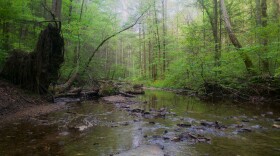-
The EPA is moving to narrow the definitions of protected waterways under the Clean Water Act, opening many waterways to pollution and destruction.
-
A protected wildlife corridor at Bernheim Forest and Arboretum has been cleared to make way for LG&E's Bullitt County natural gas pipeline.
-
President Donald Trump offered to cut coal plants a break on a significant air pollution rule.
-
When landowners spread sludge, PFAS can wash off fields into nearby rivers, leach into the groundwater, be absorbed by plants and pollute local drinking water.
-
U.S. District Judge Benjamin Beaton decided that the Biden administration rule to set climate targets for vehicles was beyond the administration’s scope. He called it “arbitrary and capricious.”
-
A former Eastern Kentucky coal mine is being revived into a storage facility that creates hydroelectric power. Gov. Andy Beshear joined officials on Thursday from the U.S. Department of Energy to announce the project in Bell County.
-
The bill would create a new state commission stacked with representatives from fossil fuel industries to review proposed power plant retirements.
-
The meeting at Marshall County Public Library’s Calvert City branch followed the recent release of the results of an emissions study that found elevated levels of volatile organic compounds, or VOCs, originating from Westlake Vinyls in the Calvert City Industrial Complex.
-
Last week’s order from the Kentucky Public Service Commission was the first time in state history an electric utility was required to receive approval to retire fossil fuel generating units. That’s because Kentucky’s Republican-led Legislature and Democratic Gov. Andy Beshear recently approved a law making it harder for utilities to retire coal-fired power.
-
The latest results from Fifth National Climate Assessment find Kentucky and the rest of the Southeast are particularly vulnerable to climate change, but that regional leaders are failing to make informed decisions that could help avoid the worst impacts.
Play Live Radio
Next Up:
0:00
0:00
Available On Air Stations










